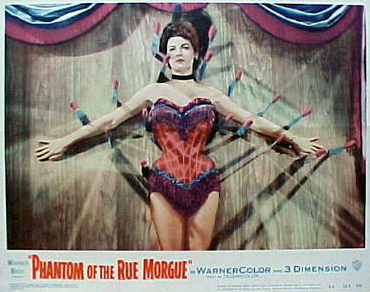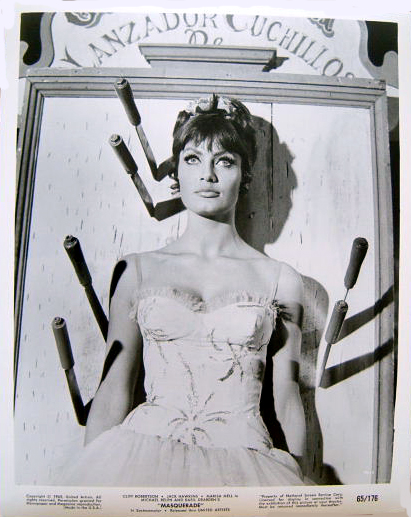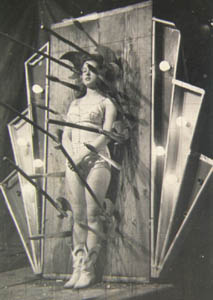ONCE YOU GET THE HANG OF IT
“I experimented with knife throwing as a consequence of writing Absinthe and Flamethrowers. It’s quite entertaining and I’ve been recommending knife throwing anyone who’ll listen (well, almost anyone.) It’s much different experience than, say, throwing pub darts. To me, one really can’t compare the bold, red-blooded flush of satisfaction derived from a perfect, cold steel stick in a target with the rather dainty, epicene feeling one gets when tossing a dart. It’s harder to learn, but once you get the hang of it, it’s a terrific.”
Knife throwers, as portrayed in popular culture are usually strange and menacing; from crazy Bill the Butcher in Gangs of New York to the murderous twins Mischka and Grischka in Octopussy, to Rookwood in V for Vendetta. Knife throwers in the media are invariably portrayed as somewhat pathological, and at the very least, shamefully dysfunctional.
From a practical point of view, and as a means of self defense, throwing a knife is not a good option, as you will give your opponent a weapon. And in a difficult situation, you will most likely not be able to throw the knife accurately enough to wound and not enrage your opponent. This is why most martial arts and self-defense experts are opposed to using this option in a non-desperate situation. Today, knife throwing has of course followers in the circus arts who perform so called impalement acts, where they frame their assistant, mostly female, with knives or do other stunts. But the sport has become attractive to a larger audience, who throw knives as a pastime in their backyard, and even gather for conventions and competitions….

"'Elizabeth Collins' is almost unique in having effectively ended up with top billing in the knife throwing act she formed with her husband Martin Collins. This British couple began performing in the 1940s as "Elizabeth and Collins". As their signature stunt the couple developed an extremely demanding trick that involved Elizabeth spinning on a "wheel of death" target while her husband balanced on a tightrope and threw knives at her. Elizabeth retired from performing in the early 1960s and was replaced by their daughter Agnes, although the act was still billed as "Elizabeth and Collins" and made various television appearances under that name"
In America, the throwing knife gained popularity in the early 1800s with James Bowie, an American soldier whose knife-throwing battles during the Texas Revolution (including his death at the Battle of the Alamo) became legendary. During this time, knife-throwing was popular among many Confederate soldiers as a form of fighting, but it was also used as a form of entertainment when the soldiers were not fighting.
The origin of knife-throwing stems from throwing wood, such as a boomerang , which was used as a weapon in battle and as a tool for hunting. In North Africa, evidence of throwing wood dates back to approximately 6000 B.C. In Egypt, throwing wood was discovered in the grave of Tut-anch-Amun (approximately 1340 B.C.). After the introduction of iron at about 600 B.C., throwing wood gradually developed into the throwing knife. It was really in Africa that the most artistic and nastiest throwing implements were developed.
“African throwing knives reside in that realm of especially imaginative human creations where expertise and experimentation have led to something amazing. They are clearly the product of much thought and hard labor, and it is certain that many minds contributed to their refinement and the multitude of specific types over decades and centuries. Indeed, a proliferation of deeplycreative forms and conceptualizations of weapons, objects of stature, and symbols of leadership constitute an important chapter in the history of central African expressive culture. These objects—framed in highly effective iron technology and frequently exercised aesthetic acumen— fascinated Europeans, who seem to have begun collecting them and much other amazingweaponry as soon as their beachheads of trade and “exploration” were established.” ( Patrick McNaughton )
Although these knives belong now to the tranquil precincts of museums and private art collections, they were designed with a very different view; namely murder, mayhem and sacrifice. The tribes who made them inhabit a vast area of equatorial Africa, from Gabon deep into the lands of the Congo and northward into the Sahara. The art of making such weapons is dying out now; no one knows exactly when it began, but iron smelting in Africa dates back to several centuries before Christ.
Throwing knives, like the ones presented in this blog, are generally from twelve to eighteen inches long.

- “This throwing knife is of the winged type and is an extremely functional weapon. It is thrown low and horizontal to the ground, spinning like a multi-armed and lethal boomerang. Throwing knives of this form are found across much of Central and Sudanic Africa and particularly along the Ubangi River, a long tributary of the Congo, where this example was collected over 100 years ago.”
Some elaborately decorated swords and knives have non-functional blades and are intended to be carried by chiefs to symbolize status and add glamor to the royal presence. Below:This ‘bird-headed’ knife is known as an onzil and was made by the Fang people of Gabon. The Fang are renowned for their refined sculptural forms, particularly reliquary heads. Although classified as a throwing knife, it is possible that the onzil was never used as a functional weapon. Instead, being closely associated with its owner, it was worn as a symbol of social status in life, and then placed on their tomb alongside the reliquary figures in death.
Below:This is a throwing knife or kpinga of the Azande people, originally of Nubia, an ancient kingdom in the area covering southern Egypt and northern Sudan.
Kpinga have three sharp blades of different shapes and this example has small barbs on its flat plate tang, which might have secured a now-missing handle binding. Even the front edge of the main shaft is sharpened.
Such weapons possessed strong cultural significance for the Azande. They were considered ‘Court Metal’, that is, weaponry produced only under the patronage of the powerful Avongara clan, and then distributed to the regiments of professional warriors in wartime. During large-scale warfare, full-time regiments were swelled by all able and willing adult males, and in this situation, the kpinga was a powerful symbol marking out the professional soldier from the land army. Kpinga were also closely associated with the masculine power of the Zande warrior, and were part of the marriage price paid by an Azande man to the family of his prospective wife.

- “The kpinga was thrown in a particular way depending on its target. The presence of three blades set at different angles ensured that at whatever point it struck it was sure to inflict some damage, the large blade effecting a slice and the smaller blades delivering punctures. Even a blow by the blunt handle might cause considerable impact injury. “
Now these have been called a number of different names, most notably “Shongo”, “Kpinga”, “Sapa” and one of the most popular: “Hunga-Munga”, names which seem to be used, incorrectly, to describe nearly every form of this kind of blade. It is important to remember that, as you can see from just the examples above, there are actually many different variations on this blade, each from their own unique African tribe; many of them were not named, and the ones that were likely had a unique name depending on where it was made and which tribe it was from. But one thing is universally certain, these are some serious throwing blades, no matter categorization and terminology used.
To safely control such a weapon in battle, you need a handle. But adding handles always reduces the chances for a throwing weapon to stick, due to the possibility of the handle hitting the target.
Their solution was to build a small handle into the design, and skillfully position the blades so that the desired balance of the weapon was not negatively affected, angling all of the points in one direction, and then shrouding the handle with a blade pointing in the same direction. The end result? A directional throwing knife with almost the same the sticking potential of the much smaller shuriken, the mass of a throwing axe, with a safe, built in throwing handle for maximum power and control.
“What was even scarier about these weapons is that their design is such that, if they hit the side of an opponents shield, its rotating momentum and mass would keep it rotating long enough to cause it to hook on to the edge of the shield and rotate around it and hit the unfortunate victim on the other side. Talk about a clever (albeit very mean) design. Throw in their size, their sharp lines and (of course!) their many pointy bits, you can probably see why I like these weapons so much. Their dark metallic finish just adds to their evil charm. They are just so freaking cool and intimidating all at the same time, on so many levels… What more is there to say?”






I wrote on the subject, but am not knowledgeable enough to get into the detail regarding gender and status, though its a major factor. There is is a link in the first paragraph of the article to a book written by William Gurstelle I believe, who went into the subject more comprehensively. I sympathize with you that information is kind of skimpy on the subject and I had to get creative to fill the space. I think this Gurstelle is the best link. If it doesn’t pan out, let me know and I,ll look through the other tags.